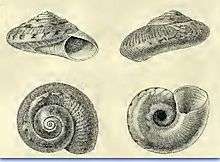Ilanga fulgens
Ilanga fulgens is a species of sea snail, a marine gastropod mollusk in the family Solariellidae.[1]
| Ilanga fulgens | |
|---|---|
 | |
| Drawing with four views of a shell of Ilanga fulgens | |
| Scientific classification | |
| Kingdom: | Animalia |
| Phylum: | Mollusca |
| Class: | Gastropoda |
| Clade: | Vetigastropoda |
| Order: | Trochida |
| Superfamily: | Trochoidea |
| Family: | Solariellidae |
| Genus: | Ilanga |
| Species: | I. fulgens |
| Binomial name | |
| Ilanga fulgens (Dall, 1907) | |
| Synonyms | |
| |
Description
(Original description by M. Schepman) The size of the shell varies between 5 mm and 12 mm. The shell has a depressed, slightly conical shape. It is rather thin. The upper surface is yellowish-white, with ziczac-lines and blotches of yellowish-brown, forming more or less distinct bands, of which one, consisting of triangular white spots and very small blotches, borders the suture. A peripheral band is distinctly articulated with white and brown and an intermediate band of more arrow-headed blotches. The interstices are filled by the yellowish-brown lines, which are often confluent, leaving only small whitish spots. The basal surface is lighter, with scarce markings, of which a band of blotches, bordering the umbilicus, is the most conspicuous.
The shell contains about five whorls. The nucleus is smooth. The next two whorls contain a few (3 or 4) lirae, which are slightly irregular, the upper one is beaded. The lirae become less distinct, being broader and flatter on the next whorl, and are transferred in distant striae with smooth interstices. The infrasutural beads, cease on the penultimate whorl. Besides this sculpture, the whole shell has a smooth, shining appearance, with very fine lines of growth. The body whorl has only a few spiral striae near the periphery. The whorls are slightly convex, the last one is a little depressed and much enlarged, but has no keel. The basal surface is smooth, with fine lines of growth and short, radiating striae round the umbilicus, which is large, pervious, funnel-shaped, sculptured with lines of growth and about 9 spiral lirae. The aperture is subcircular, slightly angular above and compressed near the periphery. The outer margin is thin. The columellar margin is sinuous, thickened, slightly reflected above, running without appreciable angle into the basal margin. The interior of the aperture is nacreous.[2]
Distribution
This marine species occurs in the East China Sea, off Japan, the Philippines and Australia.
References
- Microgaza fulgens Dall, 1907. Retrieved through: World Register of Marine Species on 22 April 2010.
- Schepman 1908-1913, The Prosobranchia of the Siboga Expedition; Leyden,E. J. Brill,1908-13 (described as Solariella zacalloides)
- Higo, S., Callomon, P. & Goto, Y. (1999). Catalogue and bibliography of the marine shell-bearing Mollusca of Japan. Osaka. : Elle Scientific Publications. 749 pp.
- Poppe G.T., Tagaro S.P. & Dekker H. (2006) The Seguenziidae, Chilodontidae, Trochidae, Calliostomatidae and Solariellidae of the Philippine Islands. Visaya Supplement 2: 1–228. page(s): 129
- Vilvens C. (2009). New species and new records of Solariellidae (Gastropoda: Trochoidea) from Indonesia and Taiwan. Novapex 10(3): 69-96
External links
- "Microgaza fulgens". Gastropods.com. Retrieved 16 January 2019.
- Dall W.H. (1907). Descriptions of new species of shells, chiefly Buccinidae, from the dredgings of the U.S.S. "Albatross" during 1906, in the northwestern Pacific, Bering, Okhotsk, and Japanese Seas. Smithsonian Miscellaneous Collections. 50(2): 139-173
- Vilvens C. & Williams S.T. (2020). New species of Ilanga (Gastropoda: Trochoidea: Solariellidae) from the Indo-West Pacific. Zootaxa. 4732(2): 201-257